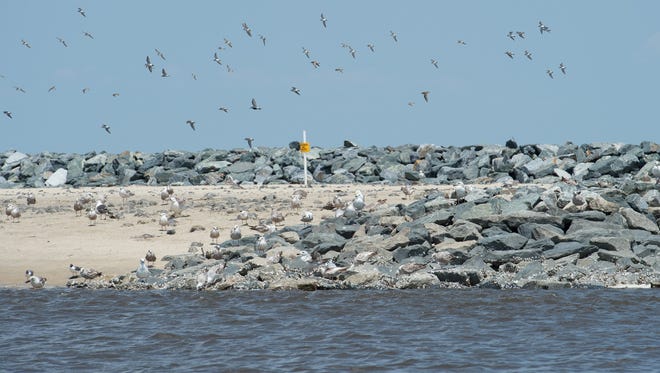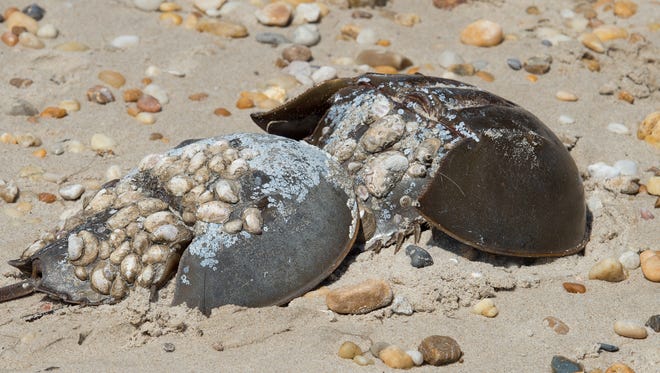Moonlight lovers feed the masses on restored beach at Mispillion Harbor
 Maddy Lauria
Maddy Lauria
Forget about the birds and the bees.
In southern Delaware, life lessons about courtship and reproduction can be found in the birds and the horseshoe crabs.
On summer nights along the Delaware Bay, when the moon is full and the tide is high, ancient-looking horseshoe crabs clumsily clamor in the surf to spawn a new generation, just as their predecessors have for millions of years.
For shorebirds traveling thousands of miles, stopping in Delaware to feast on those horseshoe crab eggs is key to survival. Without the protein-packed seaside buffet, they would never be able to finish their journey.
But in 2012, Superstorm Sandy stole a good portion of coastal habitat, key spawning and nesting grounds for the crabs and birds and caused about $68 billion in damages along the coast.
“I’d like to say that we’re never going to see a storm like that ever again. Wrong,” said U.S. Sen. Tom Carper. “We’re living in a world today where extreme weather is common, becoming more common, and we have to expect that and we have to do something about it.”
By leveraging $5.8 million in federal funding with about $2 million in state matching funds, more horseshoe crabs and shorebirds have space to reproduce and dine at Mispillion Harbor, where the Mispillion River meets the Delaware Bay.
The new habitat celebrated on Friday afternoon expands on a nearly 200-year-old jetty aimed at artificially sheltering the harbor, mainly for navigation purposes. In the 1980s, that wooden work was replaced by a rock structure.
Now a sandy beach leans against rocky groins extending into the harbor, teeming with horseshoe crabs, gulls, red knots and a slew of other birds taking advantage of a manmade project that was just completed this spring.

“Not only are you restoring the harbor here and the protections around the harbor to preserve it, but (have done so) in a way that mitigates future damage from those other future storms,” Carper said.
The nearly $8 million project made up of rocks and sand not only provides vital habitat for dozens of species like horseshoe crabs and red knots, but also is expected to bolster the area’s tourism and provide additional protection for the area’s homes and businesses.

“It may sound like a high number, but it really isn’t when you think about all of the benefits, not just to wildlife, but to the communities that live there as well as the state’s tourism,” said Wendi Weber, U.S. Fish & Wildlife Service’s northeast regional director. “Not only does it benefit wildlife, as invaluable as that is, but look at all it brings with it: tourism, jobs to do it, it protects communities. When you have a healthy ecosystem, the communities behind there are protected because Mother Nature can really absorb some of that wave energy.”
Not only that, but the success of a $38 million restoration project at Prime Hook National Wildlife Refuge depended on the work done at Mispillion Harbor, Weber said.
Without the rock and sand structure protecting the harbor, the hydrology of the connecting systems was compromised and threatened to cut off the salt water supply to Prime Hook, she said.
“If this project wasn’t done, the water source to Slaughter Creek would have been cut off, which provides a really good healthy flow," Weber said. "It’s helping bring in the salty water to restore that marsh restoration. So, all those plantings they did at Prime Hook wouldn’t have rebounded and grown as fast as they have without all of that water flowing through. It connected the systems.”
Fowler Beach at Prime Hook also has been seeing a good response from wildlife, where biologists say vulnerable piping plovers have started to nest and raise their young for the first time in decades. The expanded beach there also has been attracting horseshoe crabs and the migrating shorebirds that feast on their eggs.

Mispillion Harbor and nearby Slaughter Beach attract some of the largest congregations of those moonlight lovers celebrated on Friday. Department of Natural Resources and Environmental Control Secretary Shawn Garvin said that crabs in this area can be found at concentrations more than 100 times that of other Delaware Bay beaches.
“Mispillion Harbor is globally renown for each spring spawning of horseshoe crabs and the shorebirds that stop here to refuel on horseshoe crab eggs before continuing the long journey north,” he said as shorebirds flitted around in the background. “This unique area, with its sheltered sandy beaches and calm waters, provides ideal conditions for both the horseshoe crabs and the shorebirds, including the red knot.”

But life as a horseshoe crab or shorebird — especially the threatened Rufa red knot — is not always a romantic story.
Each spring and summer, a female horseshoe crab can lay up to 80,000 eggs. But fewer than 1 percent will make it, said U.S. Fish & Wildlife Delaware Bay Estuary Project Supervisor Gregory Breese.
“And how many animals can you walk up to on the beach and touch,” Breese said as he glanced over his shoulder as Carper and others examined and held a male and female pair of horseshoe crabs stranded in the sand on Slaughter Beach. “They’re relatively unchanged for 400 million years.”

As for shorebirds, red knots are known to arrive on the Delaware Bay completely emaciated as they break from their 9,300-mile flight from southern South America to the Arctic. Because those birds are so dependent on gaining weight during their stop in Delaware, it is important for people to keep their distance and avoid disturbing them during their bay side buffet dining.
Horseshoe crabs will be spawning along the Delaware Bay and Inland Bays until mid-July, and people are encouraged to give them a hand by flipping them over if they are spotted on their backs in the sand. Breese said the creatures are largely harmless, but advised against picking them up by their long, pointy tails because of the muscle damage that can cause.
“They are one of the most widely studied marine animals,” he said. “They’re fascinating critters. They’re just amazing and so approachable.”
Contact reporter Maddy Lauria at (302) 345-0608, mlauria@delawareonline.com or on Twitter @MaddyinMilford.
DELAWARE'S CRITTERS
Endangered piping plovers find new place to raise a family at restored Delaware beach
It’s hard being a bat, but people can help a struggling species
North Atlantic right whales threatened by climate change and human encounters